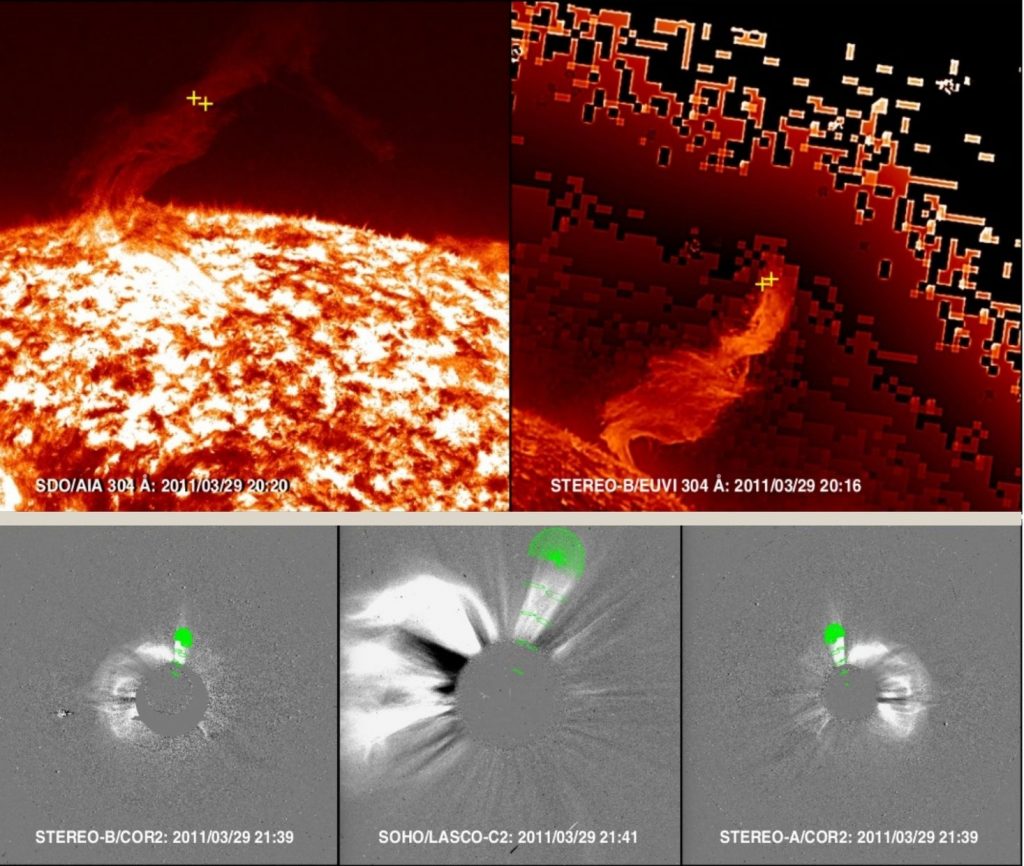Researchers from the Institute of Theoretical and Experimental Astronomy (IATE), together with an international team, published an article in which, based on observations, the deviations of solar material ejections are studied.
By Facundo Rodriguez
facundo.rodriguez@unc.edu.ar
The Sun is the closest star to our planet and the largest body in the solar system. However, it is still a challenge to understand the details of its structure and the origin of certain phenomena that occur there. For this reason, research teams from several countries are working together to explain how plasma behaves in the outer layers of the Sun, where temperatures are very high and magnetic fields are intense. One of these teams is the Astrophysical Plasma group at IATE.
The outermost layer of the Sun is called 'corona', and there are large amounts of plasma (ionised gas due to high temperatures), electric and magnetic fields in it. The configuration and intensity of these fields originate different structures such as arcs, coronal holes and filaments. On the other hand, there are occasions when some of the material on the solar surface is released through eruptions, called 'solar ejections', which release large amounts of energy. Understanding how these ejections behave is of great importance, among other reasons, because when their material is released, it can reach our planet and generate solar storms.
Observations
“In this study we worked with several telescopes simultaneously, both spatial and terrestrial located in different positions with respect to the Sun-Earth line, in order to obtain a detailed three-dimensional image of the structures we were analyzing”, says Valeria Sieyra, who did her PhD at IATE, where she started with this project, and is currently a postdoctoral fellow at the Center for Sustainable Development Studies (CEDS) of the National Technological University - Regional Faculty of Mendoza. She adds: “This is the only study that has such a comprehensive and numerous analysis of solar ejections and their associated filaments”.

This work began in 2018 with the visit of Mariana Cécere and Valeria Sieyra to the Royal Observatory of Belgium. Advised by Hebe Cremades, a researcher from CONICET specialised in solar ejection observations, they started there the analysis of approximately 300 solar ejections observed between October 2010 and September 2011, with the collaboration of local researchers and with specific funding for that purpose. Besides Hebe Cremades, who made important contributions to the analysis, Abril Sahade and Andrea Costa from IATE also collaborated.
After an exhaustive study of each of the observed events, 13 of them which showed a large three-dimensional deflection were selected for further study. In addition to analysing these structures in three dimensions, the diversity of telescopes used made it possible to obtain images at different wavelengths and at different heights in the corona, thus achieving a better understanding of the phenomena that govern these structures.
Results
"From this work, we were able to follow the three-dimensional trajectory of the ejected material, not only in the high corona (something that had already been studied) but also in great detail in the low/medium corona. This helped us to understand how the surrounding medium directs the ejection, a study that had not been carried out in such detail before," explains Mariana Cécere, an IATE researcher who has worked intensively on analysing these phenomena, both in observations and in simulations. She adds, "However, if we want to describe more accurately the complexity of the structures that direct the ejection in the low corona, more realistic models are needed than those available”.

The research carried out, in addition to being published in the journal Solar Physics, was recognised by the editor, due to the results obtained and the important contribution it makes to the area of Solar Physics. This distinction is given to only a small percentage of the papers published there.
Scientific publication |
| Analysis of Large Deflections of Prominence–CME Events during the Rising Phase of Solar Cycle 24
Authors | M. Valeria Sieyra, Mariana Cécere, Hebe Cremades, Francisco A. Iglesias, Abril Sahade, Marilena Mierla, Guillermo Stenborg, Andrea Costa, Matthew J. West & Elke D’Huys. |
